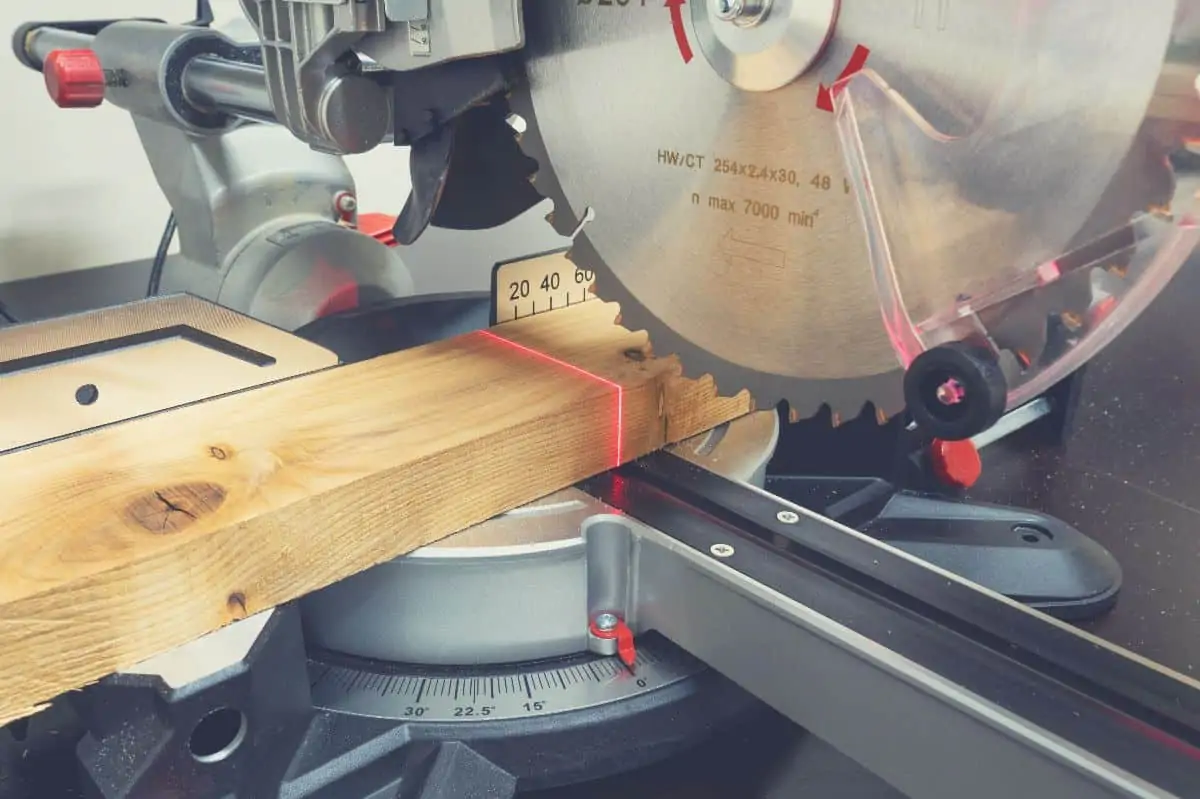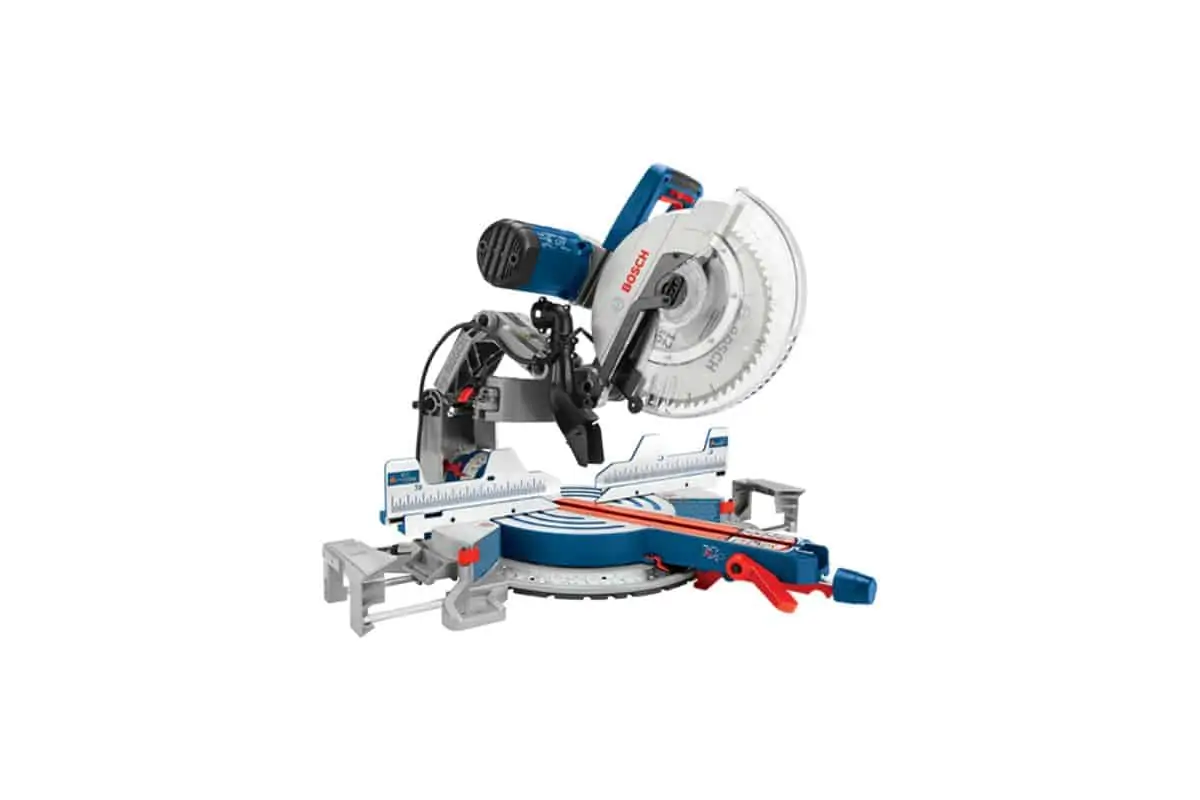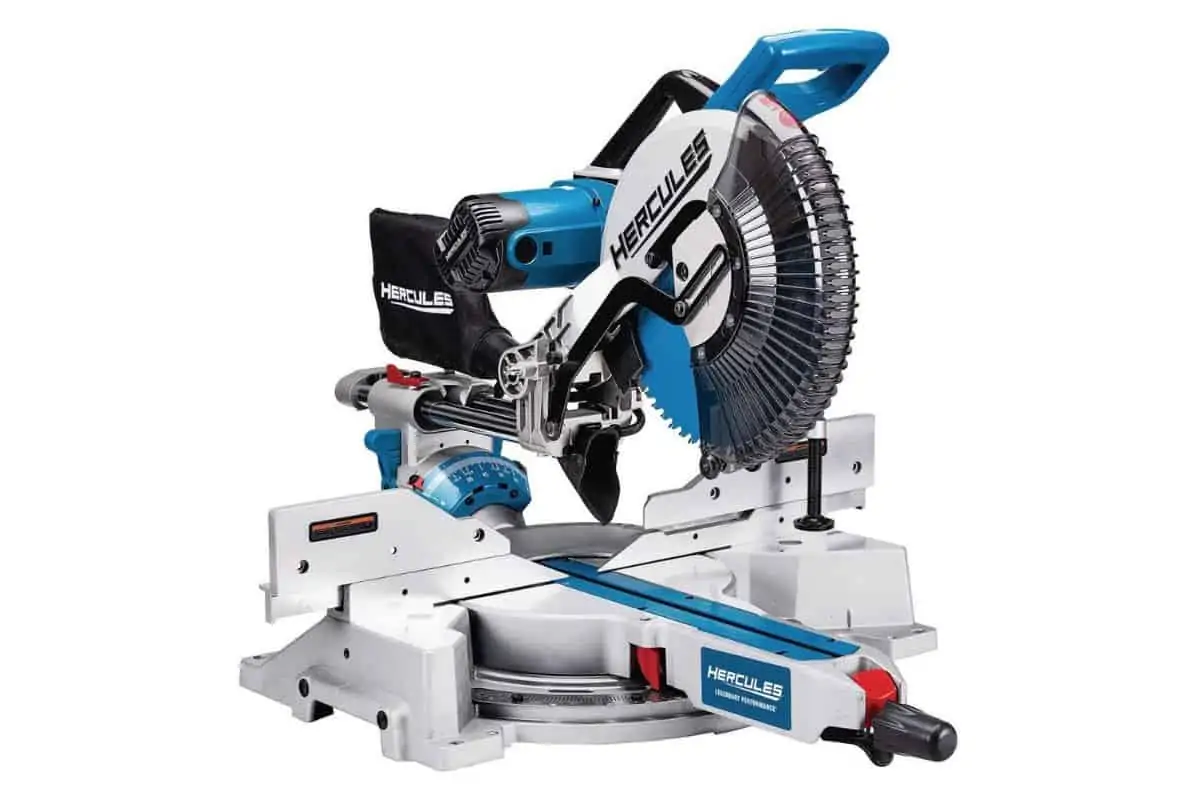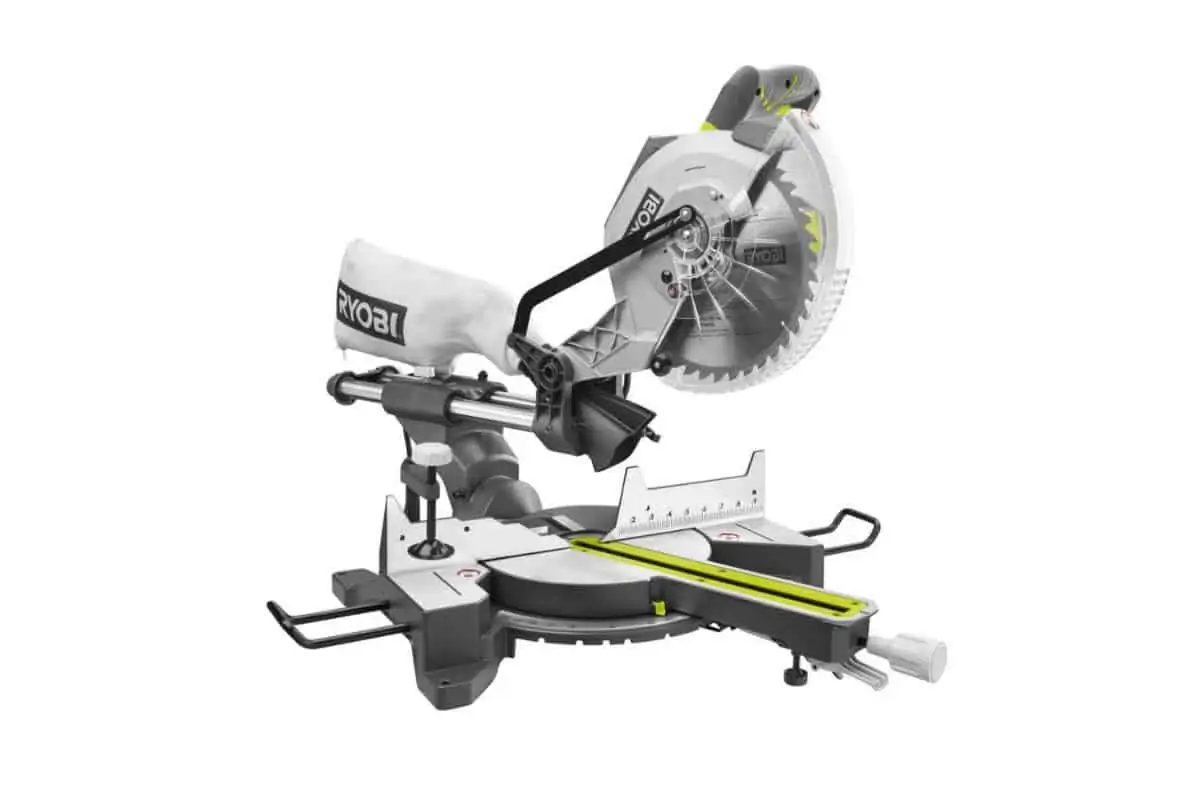Even the best miter saw needs an excellent blade to accompany it. Choosing the right one makes all the difference when it comes to making the cut for your projects, and there are a lot of blades out there.
Ready to learn? I’ll break down the best miter saw blades available. Then help you make sure that you have the right one for your next DIY or work project.
Here’s a quick roundup of the best miter saw blades:
Our Top Picks for Best Miter Blades Saws 2023
- Top 12″ Pick – Freud D12100X -12-Inch Blade, 100 Tooth
- Top 10″ Pick – Makita A-93681 -10-Inch Blade, 80 Tooth
- Hitachi 725206 72-Teeth Tungsten Carbide
- DEWALT DW3128P5 Miter Saw Blade
- Freud D1060X Diablo 10-Inch 60 Tooth Blade
- Metabo HPT 115435M 10-Inch 60T, Fine Finish Miter Saw/Table Saw Blade
- DEWALT DWAFV31278 Flexvolt 78T
- Amana Tool A.G.E. Series MD12-106 Heavy Duty Blade
- TOMAX 12-Inch 80 Teeth ATB Blade
- IRWIN Tools MARATHON Carbide Blade 14074
Our Top Pick for 12” Miter Saw Blade
Freud D12100X -12-Inch Blade, 100 Tooth
For the home DIY, I believe that the Freud D12100X is the perfect saw blade. It cuts nice and clean, is adaptable to a variety of situations, and it’s created to last for a long time.
This saw blade is a high quality carbide composite. The hard material will last for much longer than high-speed steel. It also means it cuts through even the hardest woods without issue.
The tooth design does slow the feed rate a bit compared to saw blades designed only to rip, but it’s made up for with a very smooth finish. For work at home, the slower feed rate doesn’t matter much, although it can be a concern on job sites.
Pros
- Smooth finish
- Durable construction
- Versatile
Cons
- A bit slow for some professional applications
- High-end pricing
Recommending just one saw blade is hard, but if you’ve never owned a high quality, carbide tipped blade I recommend this one. It’s leagues apart from those below it, and that includes high-end brands like DeWalt and Bosch.
Our Top Pick for 10” Miter Saw Blade
Makita A-93681 -10-Inch Blade, 80 Tooth
If you’re running a smaller saw, then you don’t have to worry. There are still great blades around, and Makita has delivered with their 80-tooth, 10-inch A-93681 miter saw blade.
This miter saw blade boasts 80 micro grain carbide teeth. It’ll make short work of wood, and even leave the ends smooth in most cases. The cost-to-value ratio here is incredible, especially since it appears to have serious longevity.
It’s not perfect. The worst thing about it is the “singing” it makes in some miter saws. The gullets create a loud noise as it runs, but that can be minimized by making sure everything is balanced properly.
For a 10 saw blade? It’s definitely worth the asking price.
Pros
- Ultra-thin kerf
- Leaves smooth cuts
- Excellent build-quality overall
Cons
- Noisy
- Not the best choice for speedy cutting
If you’re looking to upgrade your 10 inch miter saw, then check it out by clicking below.
Other Miter Saw Blades Worthy of Consideration
While the two blades above clinched the top spots for top pick and top value pick, which blade is best for you will depend on the type of work you’ll be doing. The remaining blade on this list are definitely worth a look if the blades discussed so far didn’t fit the bill.
Hitachi 725206 72-Teeth Tungsten Carbide
As an alternative to my favorite for the 10 inch miter saw blade, this micro grain carbide tipped blade from Hitachi is a great companion for your home workshop. Featuring 72 carbide tipped teeth for a smoother finish, it does the trick while remaining affordable.
This particular saw blade is meant for miter saws and designed with their high RPM in mind. It makes smooth cuts through molding, trim, and other thin workpieces without tearing out the back.
The only issue with it is that it’s meant for cross-cutting and not rip cutting. If your primary work is going to involve ripping then you’d be better served with another choice.
For finish work it’s a champ, making the grade even for professionals.
Pros
- Perfect for cross cuts
- Thin kerf
- Durable construction
Cons
- Loud in operation
- Not suitable for ripping
If cross-cutting is on your mind, and you’re working with a 10 inch saw, then click below to see if it’s right for you.
DEWALT DW3128P5 Miter Saw Blade
For the dedicated home carpenter, the DW3128P5 is an excellent blade for cross-cutting. The good news is that this one comes with a companion, a carbide-tipped 32 tooth blade which is ideal for ripping boards.
DeWalt delivers as usual here. It’s not a surprise that they’re making our list of top miter saw blades, but the convenient 2-pack is hard to pass up. Home carpenters often end up needing blades for both ripping and cross-cutting. It’s not as convenient as a dual-purpose blade but switching out tends to get both jobs done better.
Now, the low price of the 2-pack is great but these may not be what you’re looking for as a professional. The cuts are smooth but the durability to cut materials like oak hardwood on a daily basis just isn’t there.
For the home DIYer, however, it’s unnecessary to have that much durability. This pack, and particularly the cross-cutting blade, deserve a place on our list.
Pros
- 2-pack of blades
- Perfect for both ripping and cross cuts
- Anti-stick coating
Cons
- Not durable enough for daily use
- Sometimes leaves a bit of yellow on end of workpiece
If you’re trying to get your miter saw setup ready to tackle any challenge at home, shoot over and find the listing for this handy 2-pack.
Freud D1060X Diablo 10-Inch 60 Tooth Blade
Don’t feel left out if you were hoping for a Freud for your 10 inch saw. The Diablo blades are amazing no matter what the size and this 60-tooth professional blade is perfect for the at-home craftsman.
The key here lies in the titanium coating. It keeps the blade spinning smoothly even when it’s in a hard workpiece and creates a fine cut edge as soon as you lift it. Less finishing work is always a bonus.
It comes with a relatively high price tag, unfortunately. It’s also not a good choice for a dedicated ripping blade, but the occasional rip will be just fine.
In other words? It’s an almost-perfect finishing blade.
Pros
- Excellent edge finishing
- Extremely durable
- Titanium coating for less friction and a longer lifespan
Cons
- High priced
- Not good for dedicated ripping
10 inch miter saw blades are great for fine finishing, and this is one of the best. Give it a gander by clicking the link below!
Metabo HPT 115435M 10-Inch 60T, Fine Finish Miter Saw/Table Saw Blade
With 60 teeth and Metabo backing, this blade is a decent all-rounder for your DIY needs. It’s right at the top-end of what you can use for rip-cuts while being good for cross-cutting as well.
Versatility is often the name of the game in the home workshop, and this one fits the bill. While not the best at either task it’s certainly on the top end of what most people need around the home. Chopping 2x4s? This is the way to go.
For an excellent home cutting experience, however, it does the job easily.
Pros
- Versatile
- Runs quiet
- Anti-rust coating
Cons
- Expensive
- Not specialized
If you’re looking to get equipped, this is a fine choice. Take a look by clicking below to compare it to some of the others on the top of our list.
DEWALT DWAFV31278 Flexvolt 78T
78 teeth is a fine number for an all-around saw, and when you tack on Dewalt quality it’s hard to overlook this 12 inch saw blade.
Sneaking in with a great coating, solid build, and an exceptionally smooth cut, this blade is meant primarily for the DeWalt FlexVolt miter saws. Fortunately for us, arbors are relatively universal and you can use it with any 12 inch miter saw.
They were rather expensive when I wrote this review, which is a bit of a bummer. The blades are also in the “all rounder” category. A dedicated cross-cutting or ripping blade of the same quality will produce a better cut.
It’s a workhorse, however, that most people will find suits any task around the home.
Pros
- Good all-around
- Excellent micro grain carbide coating
- Very well constructed
Cons
- Rather expensive
- Not specialized
To add some of Dewalt quality to your garage head over to amazon to check the latest price.
Amana Tool A.G.E. Series MD12-106 Heavy Duty Blade
Professional quality comes with a high price tag, but if you want to fit your 12 inch miter saw with something special… look closer at this 100 tooth blade from Amana Tool,
A smooth cut is always good, but when you get into professional-quality tools things really get amazing. It’s designed to produce a clean finish for joinery, cabinetmaking, and trim work. And that’s where it delivers.
The downside? Well, it’s not made for rip cuts and it has a high price tag. The kerf is also a bit thicker than many blades out there.
Other than that, this is an amazing product that bears further investigation by the serious DIYer.
Pros
- High-end professional build quality
- Very smooth cuts
Cons
- Very expensive
While you should always take a look at pricing, don’t dismiss this finishing blade out of hand. Take a look and see the difference for yourself!
TOMAX 12-Inch 80 Teeth ATB Blade
Looking at professional quality tools can be tiring, sticker shock is a very real phenomenon. Fortunately, you can also find some great gems at lower prices.
For the money, I believe this is the most value you’ll get. It can be a bit daunting to look for a budget blade, and most of them are trash. This one delivers as an all-rounder with a fairly smooth finish.
The problem? Well, it’s not a Diablo or Amana Tools blade. You get what you pay for and these blades are still cheap so don’t expect a professional-level product.
If you just need it for light around-the-house duty, however, it makes a compelling argument. Why spend more on a tool that doesn’t actually get used enough for the durability to matter?
Pros
- Great price
- Excellent value
- Decent all-rounder
Cons
- Not professional quality
- Lifespan may be limited compared to more expensive blades
If you’re trying to save money on your saw blades, I recommend taking a closer look. It’s hard to find a cheap blade that stands out but you can find it here.
IRWIN Tools MARATHON Carbide Blade 14074
As a budget 10 inch miter saw blade, this option from Irwin tools may be what you’re looking for. It’s a thin-kerf, 60 tooth blade. A cheap all-rounder is hard to find, but we’ve got a good one here.
For a budget choice, it leaves a surprisingly smooth finish. You’ll also find that it works with lower-powered saws due to the thinner kerf. It also works very well on plastic or laminate molding.
The only real downside is that it doesn’t seem to have the longevity of many more expensive blades. It also lacks a coating or any of the other features that are standard on more expensive saw blades.
For budget blades, you can’t do any better. You could do a lot worse, however.
Pros
- Solid all-around performance
- Reasonably priced
- Great performance for the price
Cons
- May not have extensive longevity
- No coating or other extras
If you’re protecting your pocketbook but need a great blade? I’d suggest you take a look at their listing.
What to Look for When Choosing the Best Miter Saw Blade
There are some great multi-purpose blades out there. Most work well for taking down boards, but there is no “best blade” out there.
There’s only the best blade for the job at hand.
So, take a moment and familiarize yourself with the basics of miter saw blade construction. You’ll be doing yourself a big favor in the long run, since you’ll be able to choose the right tool for the job.
The following are all things to take into account when you’re picking a blade.
Tooth Count
Tooth count is essential when you’re selecting a saw blade.
For most ripping jobs, a saw blade in the range of 24-60 teeth is ideal. These are used for framing and other rough carpentry work, where a smooth finish doesn’t matter much.
For finer construction work, saws are usually around 80 teeth. These will provide a smooth cut and cause less chipping along the edges of the workpiece.
The whole thing is pretty simple: more teeth make for a finer cut but requires more time to feed the wood through compared to a rougher option.
The above tooth count suggestions are for cutting wood and plastic.
You can use a miter saw to cut through metal, but you’ll need an 80 tooth blade and it’s not ideal. A chop saw is a better option if you’ll be chopping metal regularly.
Tooth Shape
Tooth shape is almost as important as tooth count when you’re trying to determine whether or not the blade is right for your application.
Miter saw blades are designed for rip-cutting or cross-cutting.
The former cuts along the grain of the wood. Rip-cutting blades have a deeper “gullet” than cross-cutting blades, with fewer teeth. They chip away material efficiently by ripping along with the grain.
Cross-cutting blades are designed for a smoother cut since a cross-cut goes perpendicular to the grain of the wood. A smooth cut is desirable. Large portions of the workpiece can be easily removed by the blade if you make a cross-cut with one designed for a rip-cut.
The actual shape of the teeth varies between the types of cut.
Flat-top teeth are perfect for rip-cutting. Combined with a deep gullet, they efficiently remove material to easily flow with the wood’s grain.
Meanwhile, most cross-cutting blades are made with an alternating bevel. The chisel-like ridges alternate from the right to left between teeth, making a smooth cut.
There are other variations as well, including combination teeth that are good for both ripping and cross-cuts. Combination blades are ideal for home DIYers, since you won’t have to change over for cuts during most projects.
Diameter
Always match the diameter of the blade to your saw.
Blades for miter saws are usually found in 8”, 10”, and 12”. Larger saws can handle a larger workpiece, but smaller saws are cheaper and lighter.
10 inch is a good size for a home saw, able to cut a 2×4 at a 45° angle and a 2×6 at a 90° angle without difficulty. That should cover most home projects, but if you’re planning to cut anything larger than a 2×6 you should consider a 12 inch miter saw.
Kerf
The kerf refers to the amount of material removed when it passes through the workpiece.
It’s important to remain aware of the kerf size, especially when you’re making cuts with tight tolerances.
Thick blades can eat through a workpiece faster but remove more material. Heavy-duty blades can have a kerf of up to ⅛”.
Thinner blades can go down to 1/16” for extremely fine cuts. The problem with thin-kerf blades is that they bend easier and heat up more quickly.
For most people a standard kerf(roughly 3/32”) is fine. Thicker blades are great for thick, large workpieces but they eat a lot of material if you’re using high-end lumber for the job.
Thin kerfs are recommended any time you’re working with exotic lumber. Just make sure that you work with the limitations of the design, rather than trying to jam material through them.
Thin blades also require less power, many compact miter saws have trouble with thick kerf blades. In a miter saw a thin kerf is almost always the best option for that reason, especially since they tend to be underpowered compared to table saws.
Blade Types
Miter saw blades are mostly meant to cut wood and they’re often labeled for their purpose.
Bi-metal blades, made to cut through wood and nails, are a great example. They’re also one of the best blades to have around if you’re not sure what you’ll be doing regularly.
When it comes to working just wood, the main difference is in the cross-cut vs. ripping potential of the blade. Deep gullets allow for quicker material removal, but they can also chip edges if used to cross-cut.
Shallower gullets mean that you’ll have to cut slower, but they’re mostly seen on high tooth count blades meant for slower, finer cutting.
Miter saws aren’t good candidates for highly specialized blades like abrasives or diamond-tipped blades. In particular, you want to avoid any kind of continuous rim diamond blade. They’re meant for use with water or oil, and the high RPM of a miter saw will burn them out in no time.
If brick or steel are your intended cutting medium, you’d be better served with a different saw. Chop saws are made for slower RPM and heavier materials and are a much better choice. A few cuts may not kill the saw, but it’s a bad idea in the long run.
Blade Material
You really have two choices when it comes to material.
High-speed steel(HSS) is the cheaper option. These saw blades are very common and pretty cheap, the vast majority of DIY blades end up being made of HSS.
Micro grain carbide teeth cut faster, have better heat resistance, and are much more expensive. They even last longer.
In most cases, HSS will suffice but a carbide blade is always going to be better overall.
HSS does have one big advantage: you can sharpen it yourself. Sharpening tungsten carbide requires diamond tools and know-how, a simple file won’t cut it.
The truth is that HSS blades are becoming very rare. If you look at our top picks? There wasn’t a single HSS blade among them but they’re something to be aware of if you go looking for budget blades.
Conclusion
The best miter saw blade is always going to depend on the job you’re doing. Fortunately, you can be pointed in the right direction and even find great overall blades that will work for most DIY purposes around the home.
Honestly, if you’re not totally sure which you need, you can’t go wrong with the Freud D12100X for 12 inch saws or the Makita A-93681 for a more compact 10 inch saw. Both are great, multi-functional blades that you won’t regret having in your corner when you’re cutting.
I hope you’ve enjoyed this article and it’s helped you choose the best miter saw to suit your specific needs. If you have any questions or feedback on this guide, please don’t hesitate to leave me a message in the comment section below.













